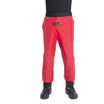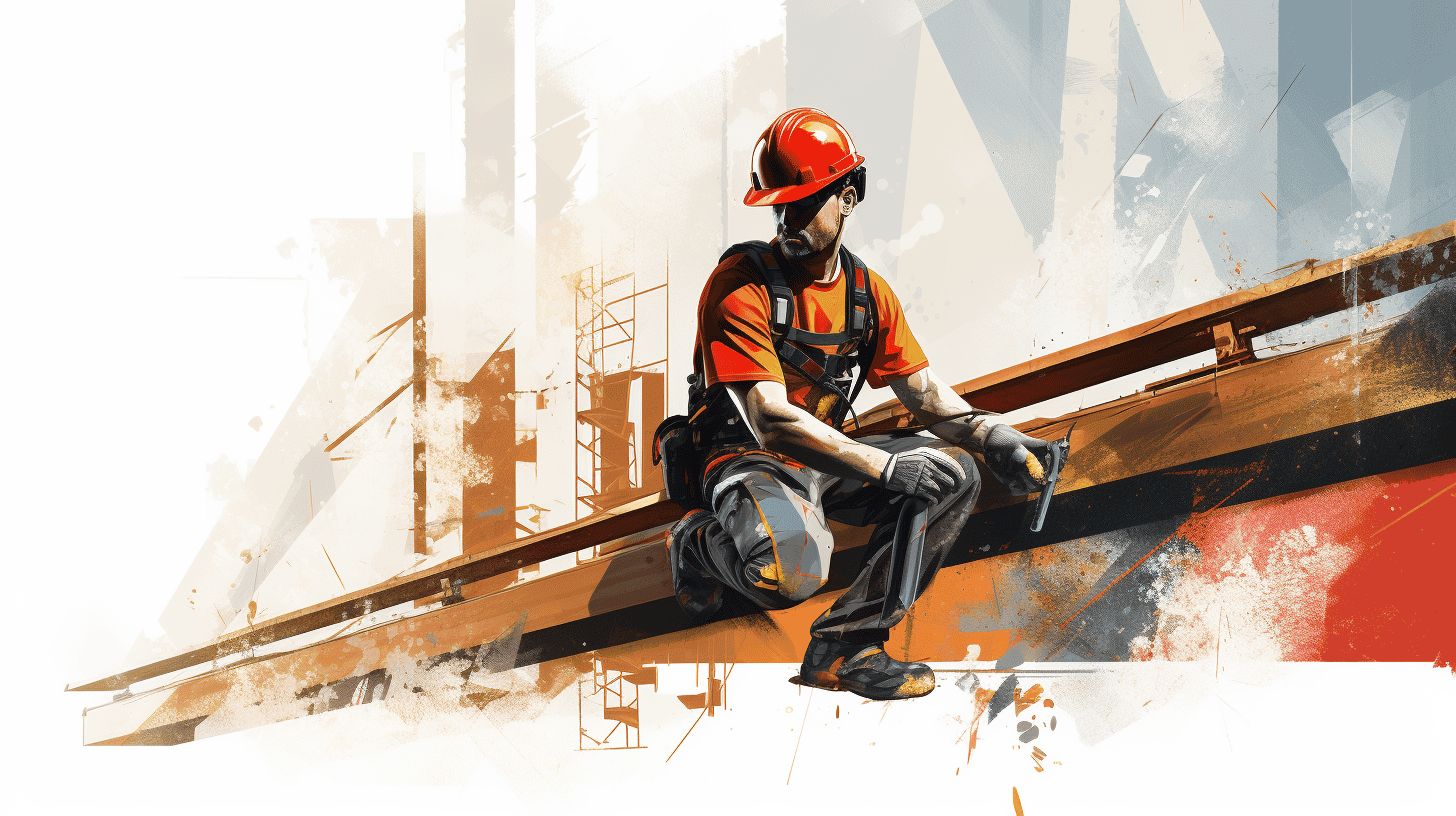As dawn breaks, construction workers across the globe gear up for a strenuous day on site. Hammering, lifting, bending, climbing - all these activities form part of a day's work in the life of a construction worker. The diurnal grind can take a toll on their bodies, resulting in fatigue and, over time, adverse health issues. This is where the concept of ergonomics finds its unique significance.
Ergonomics is the scientific study of people at work, with a focus on optimizing the interaction between workers and their environment to enhance productivity and minimize fatigue and discomfort. In the construction industry, where physical labor is intense and demanding, ergonomic gear plays a pivotal role in maintaining the wellness of workers. This article delves into how ergonomic gear can significantly reduce fatigue among construction workers, leading to increased productivity, improved health, and an overall better working environment. Let's explore deeper!
Understanding Fatigue in Construction Workers
In the bustling world of construction, where heavy machinery, precise measurements, and rigorous physical labor comprise the day-to-day operations, fatigue represents a hidden yet significant challenge. Picture an average construction worker, waking up at the crack of dawn, heading off to a demanding job possibly hours away, and returning home late in the evening. A construction worker's fatigue is more than just being 'tired'; it's a state of chronic tiredness and constant weariness. It can impair workers' vital functions, impact quality of results and heighten the risk of injury. Therefore understanding fatigue, its effects and causes in construction workers is crucial.
Effects of Fatigue
Fatigue's effects are not limited to physical exhaustion; it could be a critical matter affecting various aspects of a construction worker's life:
- Productivity Levels: Worker fatigue often results in a slowdown in productivity due to compromised physical and mental energy levels. Jobs may take longer to complete and the quality of work may suffer.
- Health Impairments: Fatigue can increase the risk of health issues, both physical and psychological. Construction workers experiencing chronic fatigue may face problems like cardiovascular diseases, diabetes, depression, anxiety, or irritability.
- Increased Safety Risks: As the level of vigilance, decision-making abilities, and coordination decreases with fatigue, the risk of accidents and injuries escalates in a construction setting, an environment already infused with inherent risk.
Common Causes of Fatigue
Recognizing the common causes of fatigue is the first step towards addressing this issue:
- Long Shifts and Overwork: Construction workers frequently deal with extended shift hours and heavy workloads, leading to insufficient rest and recovery.
- Lack of Sleep: Irregular sleep patterns or insufficient sleep, often due to travel distance or early morning/late night shifts, contribute significantly to fatigue.
- Physical Strain: Construction work often involves physically strenuous tasks like lifting heavy objects, operating machinery, or working in physically uncomfortable positions.
- Stress and Emotional issues: Workplace stressors and personal emotional challenges can also contribute to a state of chronic fatigue.
Understanding and addressing fatigue among construction workers involve recognizing its impact, identifying its prevalent causes, and implementing effective countermeasures. These include ensuring adequate rest periods, creating a balanced workload, promoting a positive work environment, and providing access to health and well-being support services. By prioritizing the well-being of construction workers, companies can create safer, more productive construction sites, and workers can lead healthier, more fulfilling lives. Remember, a well-rested and happy worker will build a stronger foundation, quite literally!
Concept of Ergonomics in Construction
Let's take a minute to discuss a particular term that's been making waves in the construction industry recently, and that, my dear reader, is 'ergonomics'. Before moving forward, let's clear the air - In simplest terms, ergonomics is the science of designing and arranging things people use so that the people and things interact most efficiently and safely. Now that we're all sailing on the same boat, it's time we dive deep into the realm of construction industry, and how ergonomics plays a key role in it.
Role of Ergonomics in Construction
Ergonomics in construction isn't limited to merely arranging tools or equipment in a functional manner. It extends to creating safe, efficient, and comfortable work environments that increase productivity while reducing the risk of work-related injuries. Below are some ways ergonomics makes a difference in the construction sector:
- Reduces Injuries: With appropriate ergonomic practices in place, industries can limit the risk of musculoskeletal disorders among workers. This means less downtime due to injuries and healthier crews.
- Improves Productivity: Believe it or not, a comfortable worker is a more productive worker. By designing work processes and stations ergonomically, employees can work more efficiently without exerting excessive physical effort.
- Enhances Job Satisfaction: Greater comfort at work leads to happier workers. And as we all know, a satisfied worker is more likely to stay with the company for a longer time.
Essentials of Ergonomic Gear
When we talk about ergonomics in construction, one cannot overlook the importance of ergonomic gear. Here's what we need to consider:
- Comfort: Choose gear that is comfortable and fits right. Tight gear can restrict movement, while loose items can become a safety hazard.
- Adaptable: Gear that can be adjusted to the worker's body size and shape will provide the most ergonomic benefits.
- Competent: Look for gear that's designed for the task at hand. For example, anti-vibration gloves for workers using vibrating tools and power equipment can reduce the risk of hand-arm vibration syndrome.
In a worker-centric field like construction, investing time and resources in ergonomics is never a waste. It enhances workforce health, ensures safety, and boost productivity - a win-win for both employees and employers alike. Remember, a healthy workspace is a happy workspace! With that said, I hope you see the value of ergonomics in construction and start implementing strategies to enhance your worksite environments. Don't worry; the benefits will speak for themselves.
Benefits of Ergonomic Gear for Construction Workers
In the construction industry, there's growing acknowledgment about the significant role ergonomic gear plays in workers' performance and health condition. Ergonomic equipment caters to the worker's comfort while minimizing the physical stress and hazard they face on the job. Here, we explore in detail the benefits of this indispensable gear for construction workers.
Reduced Fatigue
One of the main advantages of ergonomic gear is the reduction of fatigue. Construction work often involves strenuous tasks, stretching abilities to the limit and leaving workers exhausted. Here's how ergonomic gear comes to the rescue:
- Comfortable design minimizes the energy consumption tied to moving awkwardly or contrary to natural body mechanics.
- Proper support to different body parts such as back, knee, and arms reduces muscular strain, effectively mitigating fatigue.
- Body-friendly materials used capably absorb sweat, thereby lessening discomfort and distraction.
These generous features work collectively to keep workers fresh and energetic.
Increased Productivity
The success of a project chiefly relies upon the efficiency of the workers. This underscores the importance of the gear that facilitates sustained productivity:
- Lightweight gear enables workers to move freely and accomplish more tasks without feeling burdened.
- High functionality, such as features for quick adjustments or add-on tools, helps workers complete tasks swiftly.
- Well-fitted gear prevents unnecessary readjustments, letting workers focus on their tasks without inconvenience.
Put simply, ergonomic gear is synonymous with enhanced productivity in the construction realm.
Improved Health
Construction workers, exposed to potential hazards almost every day, can greatly benefit from ergonomic gear that contributes to their overall health:
- Preventing musculoskeletal disorders: Ergonomic gear aligns with a worker's natural body movements, reducing the risk of such disorders.
- Minimizing injuries: Its role in preventing trips, slips, or falls is vital. Good quality footwear with anti-slip properties, for instance, can save the day.
- Shielding against weather adversities: By providing the Best Rain Gear for Construction Workers, the gear additionally offers protection against harsh weather conditions, helping the workers stay dry and comfortable.
Conclusively, ergonomic gear, with its unparalleled efficacy in enhancing productivity, reducing fatigue, and improving health, deserves to be an integral part of every construction worker's toolkit. It's time to improve safety measures in the construction industry, and this is one step forward in that significant pursuit.
Examples of Ergonomic Gear
Imagine a day on the job, whether it's on a bustling construction site or in a fast-paced factory setting. Every movement matters, and even the slightest discomfort may lead to inefficiency - or worse, injury. That's where ergonomic gear sweeps in like a hero, making any physically demanding job safer and more manageable. Allow us to guide you through examples of these game-changers in the industry, from helmets to boots, with the ultimate vision of presenting the benefits of such equipment in occupational settings.
Ergonomic Helmets
An ergonomic helmet is more than a shield for the head; it's a comfortable, fit, and intelligent safety device. These helmets feature adjustable headbands to secure a perfect fit, and padded interiors to cushion any forceful impact. Some even have clever ventilation systems, keeping the head cool even amidst exhausting work. Remember, a well-protected worker is a productive worker - that’s the charm of ergonomic helmets.
Ergonomic Work Shirts
Perhaps the most overlooked piece of ergonomic gear, work shirts play an incredible role in guaranteeing worker comfort. Ergonomic work shirts are specially designed to provide unrestrictive movement, breathability, and durability. With the right materials, like a blend of cotton and polyester, these shirts not only last longer but also conform to the body's shape more effectively. You'd be surprised how a simple shirt can transform your workday experience!
Ergonomic Gloves
Think about the various tasks your hands perform in a workday - that's why ergonomic gloves should be at its top protection list. They offer padded grips and are crafted to deflect the stress caused by repetitive hand movements. A good pair of ergonomic gloves are not only comfortable but often feature design details that help prevent common work-related hazards such as cuts, vibration injuries, and even electrical shocks.
Ergonomic Boots
Last but not least, consider a pair of ergonomic boots, the silent heroes for the feet that bear the brunt of the work. These boots are specifically designed to offer superior ankle support and cushioned footbeds for shock absorption. Significantly reducing fatigue and the potential risk of foot injuries, they provide workers comfort throughout the day.
There's a vast array of ergonomic gear options available for every industry, one of which is the Ergonomic Denim Pro Gear. Gear, in essence, assists workers in accomplishing their tasks, but ergonomic gear changes the way they perform these tasks entirely - effectively, efficiently, and most importantly, safely. Adopting ergonomic gear isn't just an investment; it's showing a commitment to safety and productivity.
Implementing Ergonomic Practices in Construction
A growing understanding of the importance of worker wellness brings to the spotlight the critical role of introducing ergonomic practices in construction projects. Incorporating ergonomic practices means taking an active approach to ensure that the equipment, tools, and work procedures do not risk the health and safety of your workers. Keeping current with ergonomic practices is crucial for tackling work-related injuries that could be avoided and preserving the welfare and productivity of your employees.
Training and Education
Training and Education form the cornerstone of any sound ergonomic program. Without proper training, workers might lack the necessary understanding of how ergonomic risks can impact their health and safety.
In-depth educational programs can help in:
- Unveiling the concept of ergonomics, its benefits, and the risks of not considering it.
- Illustrating correct practices such as proper lifting techniques and usage of tools.
- Raising awareness about the symptoms of work-related musculoskeletal disorders, promoting early diagnosis and treatment.
Remember, a well-crafted training program can mark the difference between a safe, healthy workplace and one prone to accidents and injuries.
Consistent Use of Ergonomic Gear
One of the cornerstones of an effective ergonomic strategy is the adoption and consistent use of equipment and tools designed with the comfort and safety of workers in mind. Not only does ergonomic gear help ease the physical strain on workers, but it also contributes to productivity by enabling them to get the job done more efficiently.
Here is what ergonomic gear can achieve:
- Reduce physical strain: Ergonomic tools and equipment are designed to perform much of the heavy lifting, reducing the risk of injuries.
- Improve efficiency: Work gear fitted to the user's body has been proven to boost efficiency and productivity.
- Enhance worker's morale: Workers value employers who actively invest in their health and safety.
Implementing ergonomic gears provides a two-fold benefit—It upholds the welfare of the employees and bolsters the overall productivity and morale.
Regular Health Checks
Regular health checks for construction workers play a pivotal role in occupational health. In a sector riddled with physical strain and potential risks, early detection of issues can dramatically reduce long-term health problems.
The key components of regular health checks include:
- Identifying potential health risks: Regular health checks can help to identify potential health issues early on.
- Providing necessary treatment: Early detection allows for swift treatment, reducing downtime and ensuring the well-being of the workers.
- Promoting a culture of health: Such regimens direct attention to health and wellness, encouraging workers to take more responsibility for their wellbeing.
By integrating ergonomic practices into construction projects, we not only support the health and safety of our workers but also ensure seamless, efficient construction process. Embracing ergonomics is not just an investment in safety—it's an investment in productivity, workforce retention, and overall project success.
Conclusion
The construction industry, despite its inherent challenges, constantly innovates and pivots towards practices that boost productivity, worker safety, and overall job satisfaction. The advent of ergonomic gear has undoubtedly been a turning point in this regard. Not only does ergonomic gear shield workers from potential work-related injuries and illnesses, but it also plays a significant role in combating fatigue and escalating productivity levels.
In this light, companies like Rain Gear Pro are proving to be game-changers. The Canadian-made, Kevlar reinforced chainsaw safety pants offered by Rain Gear Pro are a shining example of ergonomic design, providing both safety and comfort to the user. By emphasizing the importance of proper training and encouraging the consistent use of ergonomic gear, construction companies can indeed ensure a safer, healthier, and more efficient work environment for their employees. Remember, when it comes to ergonomic gear in the construction world, the blend of comfort, safety, and productivity is indisputable. It's not just about reducing fatigue but winning the construction game at large.
Frequently Asked Questions
-
What is ergonomic gear?
Ergonomic gear refers to specially designed equipment and accessories that are crafted to provide comfort, support, and reduce the risk of injuries for workers by adapting to the natural human body movements.
-
Why is ergonomic gear important for construction workers?
Construction workers often perform physically demanding tasks that can lead to fatigue and injuries. Ergonomic gear helps reduce strain, improve posture, and minimize the risk of musculoskeletal disorders, enhancing worker productivity and safety.
-
What are some examples of ergonomic gear for construction workers?
Examples of ergonomic gear for construction workers include ergonomic gloves, knee pads, back support belts, anti-fatigue mats, ergonomic hand tools, and adjustable workstations.
-
How does ergonomic gear reduce fatigue?
Ergonomic gear reduces fatigue by providing proper support to the body's key areas, promoting natural alignment, reducing pressure on joints and muscles, and enhancing blood circulation. This helps prevent excessive strain and allows workers to work for longer periods without experiencing excessive tiredness.
-
Where can construction workers find ergonomic gear?
Construction workers can find ergonomic gear at specialized safety equipment stores, online marketplaces, and through their employers who may provide such gear as part of their commitment to worker safety and well-being.























Leave a comment
This site is protected by hCaptcha and the hCaptcha Privacy Policy and Terms of Service apply.